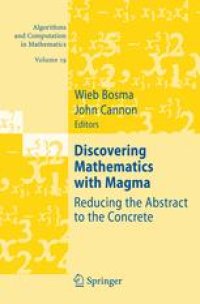
Ebook: Discovering Mathematics with Magma: Reducing the Abstract to the Concrete
- Tags: Mathematical Software, Algebra, Algorithms, Symbolic and Algebraic Manipulation
- Series: Algorithms and Computation in Mathematics 19
- Year: 2006
- Publisher: Springer-Verlag Berlin Heidelberg
- Edition: 1
- Language: English
- pdf
This volume celebrates the first decade of the Computer Algebra system Magma. With a design based on the ontology and semantics of algebra, Magma enables users to rapidly formulate and perform calculations in the more abstract parts of mathematics. This book introduces the reader to the role Magma plays in advanced mathematical research through 14 case studies which, in most cases, describe computations underpinning new theoretical results. The authors of the chapters were chosen both for their expertise in the particular field and for their innovative use of Magma. Although by no means exhaustive, the topics range over much of Magma's coverage of algorithmic algebra: from number theory and algebraic geometry, via representation theory and group theory to some branches of discrete mathematics and graph theory. A basic introduction to the Magma language is given in an appendix. The book is simultaneously an invitation to learn a new programming language in the context of contemporary research problems, and an exposition of the types of problem that can be investigated using computational algebra.
This volume celebrates the first decade of the Computer Algebra system Magma. With a design based on the ontology and semantics of algebra, Magma enables users to rapidly formulate and perform calculations in the more abstract parts of mathematics. This book introduces the reader to the role Magma plays in advanced mathematical research through 14 case studies which, in most cases, describe computations underpinning new theoretical results. The authors of the chapters were chosen both for their expertise in the particular field and for their innovative use of Magma. Although by no means exhaustive, the topics range over much of Magma's coverage of algorithmic algebra: from number theory and algebraic geometry, via representation theory and group theory to some branches of discrete mathematics and graph theory. A basic introduction to the Magma language is given in an appendix. The book is simultaneously an invitation to learn a new programming language in the context of contemporary research problems, and an exposition of the types of problem that can be investigated using computational algebra.
This volume celebrates the first decade of the Computer Algebra system Magma. With a design based on the ontology and semantics of algebra, Magma enables users to rapidly formulate and perform calculations in the more abstract parts of mathematics. This book introduces the reader to the role Magma plays in advanced mathematical research through 14 case studies which, in most cases, describe computations underpinning new theoretical results. The authors of the chapters were chosen both for their expertise in the particular field and for their innovative use of Magma. Although by no means exhaustive, the topics range over much of Magma's coverage of algorithmic algebra: from number theory and algebraic geometry, via representation theory and group theory to some branches of discrete mathematics and graph theory. A basic introduction to the Magma language is given in an appendix. The book is simultaneously an invitation to learn a new programming language in the context of contemporary research problems, and an exposition of the types of problem that can be investigated using computational algebra.
Content:
Front Matter....Pages I-XXIV
Some computational experiments in number theory....Pages 1-30
Applications of the class field theory of global fields....Pages 31-62
Some ternary Diophantine equations of signature (n, n, 2)....Pages 63-91
Studying the Birch and Swinnerton-Dyer conjecture for modular abelian varieties using Magma....Pages 93-116
Computing with the analytic Jacobian of a genus 2 curve....Pages 117-135
Graded rings and special K3 surfaces....Pages 137-159
Constructing the split octonions....Pages 161-185
Support varieties for modules....Pages 187-204
When is projectivity detected on subalgebras?....Pages 205-220
Cohomology and group extensions in Magma....Pages 221-241
Computing the primitive permutation groups of degree less than 1000....Pages 243-260
Computer aided discovery of a fast algorithm for testing conjugacy in braid groups....Pages 261-285
Searching for linear codes with large minimum distance....Pages 287-313
Colouring planar graphs....Pages 315-330
Appendix: The Magma language....Pages 331-356
Back Matter....Pages 356-374
This volume celebrates the first decade of the Computer Algebra system Magma. With a design based on the ontology and semantics of algebra, Magma enables users to rapidly formulate and perform calculations in the more abstract parts of mathematics. This book introduces the reader to the role Magma plays in advanced mathematical research through 14 case studies which, in most cases, describe computations underpinning new theoretical results. The authors of the chapters were chosen both for their expertise in the particular field and for their innovative use of Magma. Although by no means exhaustive, the topics range over much of Magma's coverage of algorithmic algebra: from number theory and algebraic geometry, via representation theory and group theory to some branches of discrete mathematics and graph theory. A basic introduction to the Magma language is given in an appendix. The book is simultaneously an invitation to learn a new programming language in the context of contemporary research problems, and an exposition of the types of problem that can be investigated using computational algebra.
Content:
Front Matter....Pages I-XXIV
Some computational experiments in number theory....Pages 1-30
Applications of the class field theory of global fields....Pages 31-62
Some ternary Diophantine equations of signature (n, n, 2)....Pages 63-91
Studying the Birch and Swinnerton-Dyer conjecture for modular abelian varieties using Magma....Pages 93-116
Computing with the analytic Jacobian of a genus 2 curve....Pages 117-135
Graded rings and special K3 surfaces....Pages 137-159
Constructing the split octonions....Pages 161-185
Support varieties for modules....Pages 187-204
When is projectivity detected on subalgebras?....Pages 205-220
Cohomology and group extensions in Magma....Pages 221-241
Computing the primitive permutation groups of degree less than 1000....Pages 243-260
Computer aided discovery of a fast algorithm for testing conjugacy in braid groups....Pages 261-285
Searching for linear codes with large minimum distance....Pages 287-313
Colouring planar graphs....Pages 315-330
Appendix: The Magma language....Pages 331-356
Back Matter....Pages 356-374
....